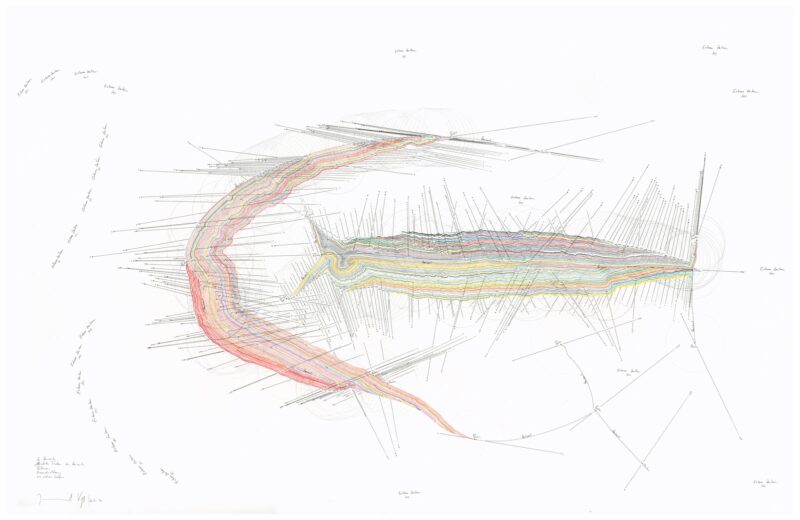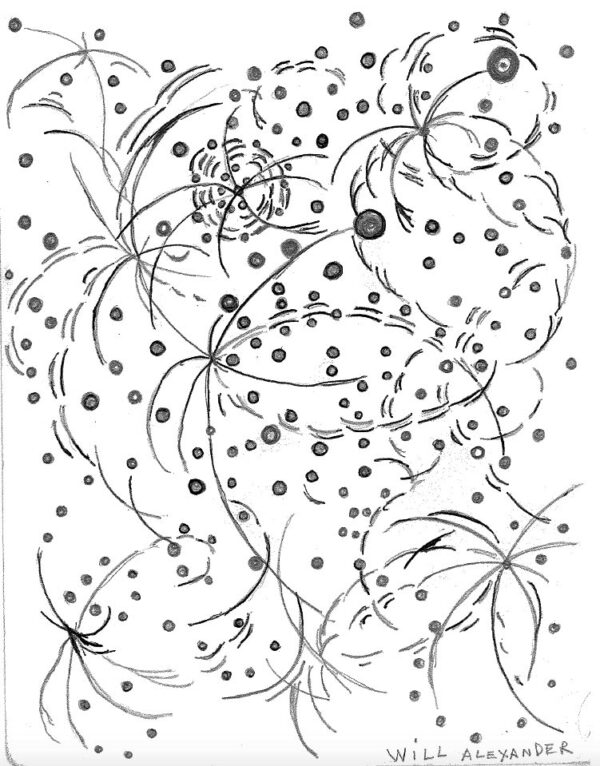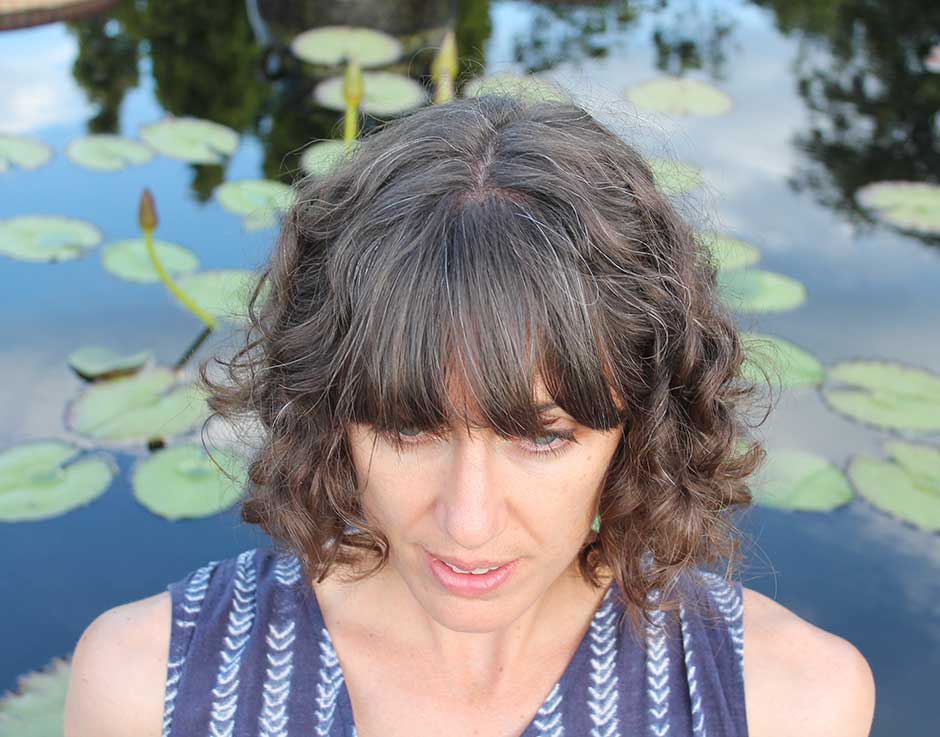Kelly Krumrie’s figuring
Uncertain, Unsettled Wonder
Figuring is a monthly column that puzzles over (to figure) and gives shape to (a figure) writing, art, and environments that integrate or concern mathematics and the sciences. This month’s column features a conversation with Mark Mayer on the Mathematics of Uncertain, Unsettled Wonder
Kelly Krumrie’s figuring
A conversation with Mark Mayer on the Mathematics of Uncertain, Unsettled Wonder
Figuring is a monthly column that puzzles over (to figure) and gives shape to (a figure) writing, art, and environments that integrate or concern mathematics and the sciences.
The last eighteen weeks have been, for me, a flurry of information and correspondence. From my house, as I’ve stayed mostly quarantined in Denver, I’ve been reaching: reaching into my computer and phone out to articles, graphs, tweets, pdfs, and to friends who reply with descriptions of rainstorms, photos of book pages, worries and complaints, videos of their kids. Normal stuff, but amplified, more visceral somehow, and sadder. Then post-protest safety check-ins, live streams of burning buildings, petitions. More flurries. A few of these communications have settled into longer form, regular email missives. These are keeping me steady, steadier than looking up facts or toggling the axes of interactive graphs. I reach, and I know a reply is coming.
Mark Mayer is one of these steady correspondents, writing from Maine, and, among many other topics, joys, and fears, we most often end up discussing mathematics. We decided to experiment a little, to limit our conversation to a question bugging the both of us: What is math good for right now? —especially as it relates to art and literature and what relationship that intersection has to the present world. Over the course of two weeks, we exchanged emails attempting to dig at this question—limiting ourselves to three sentences each (mostly) and a deadline—to see where we’d end up.
Where did we end up? Not with the answer to what math is good for in literature or life, of course, but maybe with a demonstration of what it’s good for in our email chain, where it prompted us to think in new ways about wonder and experience and reckoning. Like math and like literature, friendship is an intellectual collaboration, one that can help make the invisible quarters of the world more seen.
*
K: I am interested in writing to / with you about what is math good for (or what it might be doing) in literature (in general but also now, alongside the significance of a present—its push against or pull toward moments both rendered and real) because our literary reading and writing around and through math manifests so differently, I think. I’d like to start with writing (rather than math-in-the-world) because that seems like something I can hold in my hand—which is maybe getting at something about literature and is itself a question I have about math. When I consider the relationship between math and literature when I’m reading, for example, fiction (not explicitly mathematical texts like Oulipian projects, or not even poetic meter), I feel like I am up against a contradiction, like I am trying to make an impossible analogy fit, and I tear my hair out over what’s the point.
M: You know how the plainness, the prosaicness, of prose can work over the pages of a novel to suggest, ironically, a mysteriousness beneath its own plainness, so that fiction that dwells insistently in the surfaces of its world is often more evocative of universal mystery than the explicitly metaphysical stuff? Maybe this is why math, which is language at its plainest, feels so at home to me in fiction—because it takes this prosaic/mysterious irony and perfects it:
0.999… = x
9.999… = 10x
9.0 = 9x
1 = x
1 = 0.999…
The willies I still get from that little proof (which implies that every nonzero number can be written as an endlessly expanding decimal, like maybe numbers in their natural state are endless) are like the willies I can get from a novel when it demonstrates that the practiced routines we live by are just encasements of something mysterious, elliptical, uncontainable…
K: A few years ago, I was providing a training for middle school math teachers, and I was asking them about how to share our “awe and wonder” about math when we teach it—these willies you mention, the oh my goshness of much of it, for me—and one teacher quite literally scoffed (like, audibly) because she said what she likes about math is there is no mystery, no creativity, it’s right or wrong, plain and concrete; beauty she admitted to, but not wonder. Is that something you have encountered when you teach math or writing / literature? Especially at the intersections—how the feelings we often get (easily?) from art / literature / music translate?
M: Could it possibly be that your joyless, scoffing trainee has it half right, because the wonder of the wonder is how it emerges from something that seems so bland and tightly bound to definitions? If everything is either right or wrong, that either/or puts a fierce pressure on everything, and so when something that seems wrong is right or something that seems right is wrong, when something escapes that right/wrong trap, it’s like a tiny bubble floating upward from the seafloor expanding into a great big O of wonder. And, yes, for me it’s much like what we strive for in lit classes: that moment when a text that had been a bland bundle of words that can mean only what their definitions permit them to mean suddenly slips the trap and expands into something vaster and more wonderful than we could previously account.
K: Slipping the trap in language makes me wonder about literature as “instructions” created by the writer that manifest as something in the reader’s imagination: a cause and effect of idea, image, or feeling—and the potential for vastness. This morning I was reading a book about the sign systems of math—symbols (1, +), words used in descriptions or proofs, and diagrams—and the author asserts that mathematics “dispenses entirely with the linguistic apparatus of deixis,” meaning: the work has no time, location, or even person. The written record of a mathematical operation is descriptive in an (ideally?) objective always-present moment (in fact, Husserl wrote this truly wild line in Origin of Geometry about the Pythagorean Theorem only occurring once because its reiteration / repetition / re-use (by me, today, e.g.) is each time innately the same thing) while at the same time the written operation is predictive: if you do x to y, you get z.
M: Does that leave room for the experience of using the Pythagorean Theorem, which feels to me like a different thing when it turns up as the equation of a circle or in Pythagorean fuzzy sets or when Gauss proposes clearing forests into giant proofs of the theorem to demonstrate our intelligence to any moonfolk who might be looking down? If math and literature are “instructions” to the mind, part of their meaning is in how they stage their play inside the mind’s weird plastic, where nothing means the same thing twice. Like, it’s the same always-present moment when Hamlet stabs Polonius, and the text is just as predictive (do x to Hamlet, you get z), but again the wonder, and the meaning too, is in how something set and scripted can nonetheless surprise us.
K: Right! It’s the surprise—or maybe teetering—of this “objective” reality or rule and its manifestation in the world which is always tied up with experience or dare I say use (moon messages, art, 8th grade homework). I’m curious about writers or artists who use mathematical concepts as grounding or explanation for something abstract or impossible; like, if I graph a feeling it becomes more clear (?), e.g., Verónica Gerber Bicecci’s Empty Set where the narrator tries to make sense of or figure out her relationships to others via mathematical diagrams or Anne Caron’s Eros the Bittersweet’s triangulation of desire. Alternatively, visual artists like Agnes Martin, Jorinde Voigt, Agnes Denes, and Hanne Darboven are working with the mathematical in a way that eludes, pushes against, or even prevents a “figuring out.”

2 Horizonte; Mögliche Farben des Horizonts; Position; Himmelsrichtung; 24 Externe Zentren
Jorinde Voigt. Berlin 2010 87 x 135 cm Tinte, Ölkreide, Bleistift auf Papier Unikat Signiert
M: So describe for me—and maybe one of these poets or artists has the answer—what kind of math might reproduce (or perform or revealingly encipher) the emotional impact of experience of right now, early July 2020, for you. To be honest with you, I’m having the kind of day, kind of year, where I’m not seeking any more surprises, neither awful nor awesome, so much as I’m craving the kind of illusory certainty that math can seem to offer, which is to say the comforts your trainee invoked. It’s been a year of math, of exponential graphs and herd immunity explainers, but what kind of math do you think could say something about the experience of this year—or is this the wrong question?
K: I think this is the right question, and one I ask of other writers / artists while I kind of hide behind them, peeking out; at the same time, I am channeling my experience and physical and emotional responses into creative projects that have to do with math, specifically with the representation of numerical information (like numbers, counting, measurements) and total unknowns (love, longing, human relationships) in language. This year’s math, for me, what my eyes zoom in on, has been one of (as you mention) graphs: covid cases and deaths, police brutality and murders, police budgets, markets, “relief” checks, housing and food insecurity—I feel like I’ve spent days with too many tabs open, toggling among charts with multi-colored dotted and solid lines or bars, reminding myself to check the axes for whether a scale is linear or logarithmic; this gives me no relief. The experience of that kind of 2020 math is one of immeasurability and unfathomable scale: that each of these diagrams attempts to count and measure so that we can see what’s happening, but they’re only counting what’s countable.
M: True, it’s been a year of formidably invisible antagonists (viruses, respiratory droplets, racism coded into public policies that make no mention of race), and it’s interesting to consider math as our Visiblizer, tossing flour over invisibly systemic racism or invisibly circulating contagion so that their shapes can be perceived and a blow can maybe be struck. It’s supposed to be literature that makes the invisible visible, seeks out and finds names for the unnameable dimensions of experience, but the conventions of literature may make it blind to things that math is not: the rules of point of view and our notion of protagonism, for instance, make it very hard for narrative to animate the wildfire shape of contagiousness, and institutional racism is embedded not just in the publishing industry and the writers workshop but also, I’d argue, in the conventional short story form. So when I think about how simple fractions made musical harmony visible to the Pythagoreans or about how the angle of a shadow made the earth’s circumference visible to Eratosthenes, I do wonder how, today, literature and math might work together to help us see and name.
K: Tuesday (6/30), I “attended” a Zoom panel discussion put on by Beyond Baroque where Dorothy Wang, Janice Lee, and Will Alexander got at this a little bit: they considered poetic (as writers) and literary (as scholars and teachers) responses to “now,” especially institutional racism. I’ve been working on a paper on Will Alexander’s engagement with mathematics and its history, and I’ve touched on his work in this column, because I see in it a wild, cosmic re- and unfolding of the very possibility of mathematical truth / certainty as it is rendered in language: that mathematical concepts in poetic language can be made anew. In Tuesday’s panel, he said something to the effect of we must poeticize facts, geology, history, and vocabularies; we don’t need to repeat certainties because “we are opening into a new state of wonder,” meaning the unknown future of institutional and systemic change during a pandemic and within increasing global climate crises. 4th sentence: The panelists acknowledged that it’s hard to articulate what to do, how to write, how to interpret because of this upheaval’s newness, but in writing and the arts, we have unlimited potential to present things in infinite ways, even our ideas of math and science (and by this I mean what we do with the information we get from a graph, e.g., our interpretations, experiences, and actions in response to it, not that we need to doubt fact). 5th sentence: Upending something as certain as math, to me, is more powerful than upending something like language which is already always uncertain.

Mathematical Fuels, Will Alexander (https://durationpress.com/galleries/will-alexander/)
M: But one thing this conversation has revealed itself to be about, for me at least, is how wonder and certainty emerge from each other—how we feel wonder when certainties glitch and surprise us with something that seems impossible, how the feeling of certainty that we call “seeing” the previously invisible can feel wondrous. When we chant Black Lives Matter we’re repeating an indisputable certainty—and also demanding a new state of wonder, i.e., a state that recognizes, with wonder, the measureless value of each person’s life. We tend to think of wonder as a feeling of rug-pulling, floor-vanishing, surprised uncertainty, but it is simultaneously a feeling of surprised certainty: we are shocked by what we now must know.
K: 6 sentences: I see what you mean, and I see the hope in surprised certainty, a kind of clarity. I’ve been rereading Dionne Brand’s recent article, “On narrative, reckoning and the calculus of living and dying,” and in it she writes, “the commentators, experts, and politicians… attempt to manage the pandemic as narrative, as calculus, but not yet as reckoning.” The mathematics I see, now, as it relates to the world rather than a work of fiction or art, is one of total despair, or as Brand writes, “a calculus of living and dying” (see also Katherine McKittrick’s “Mathematics Black Life”). In the mathematics of today, right now, and a now that feels like it keeps changing, in the many forms in which I encounter it, I despair. Even while, as Brand writes, “all the metrics are off,” and this allows, similar to what Will Alexander was saying, a re-measuring or re-wondering of the world, I’m curious about reckoning over calculus. I’m drawn to reckoning—maybe because it’s a math word rather than math itself, the word tumbling open with many meanings, multi-faceted, holding potential both with and beyond number and measure that fills me with a sense of wonder, but still an unsettled wonder, though I think all wonder is kind of unsettling.

About the Author
Kelly Krumrie‘s prose, poetry, and reviews are forthcoming from or appear in Entropy, La Vague, Black Warrior Review, Full Stop, and elsewhere. She is a PhD candidate in Creative Writing at the University of Denver where she serves as the prose editor for Denver Quarterly.